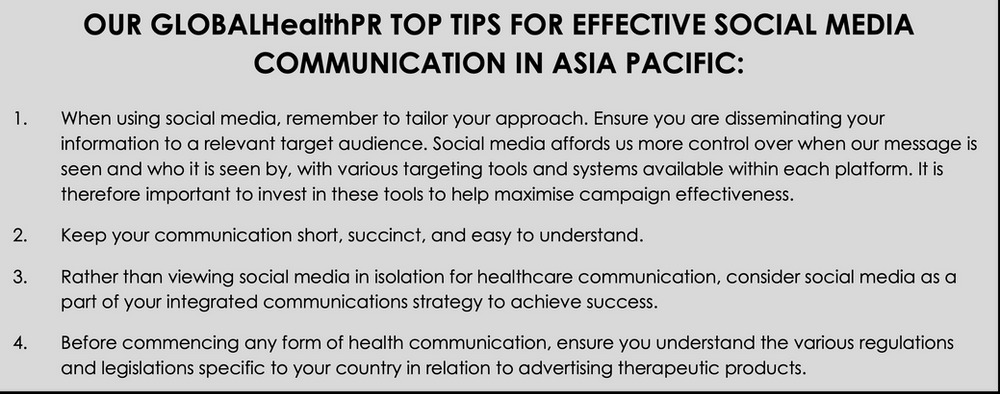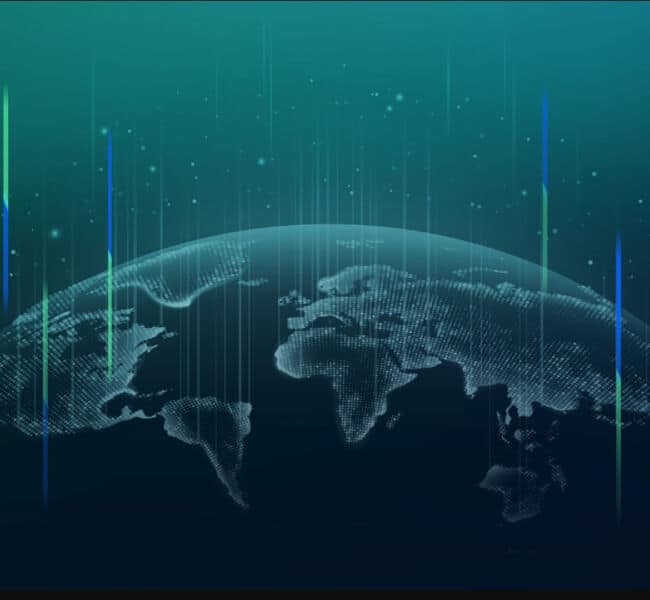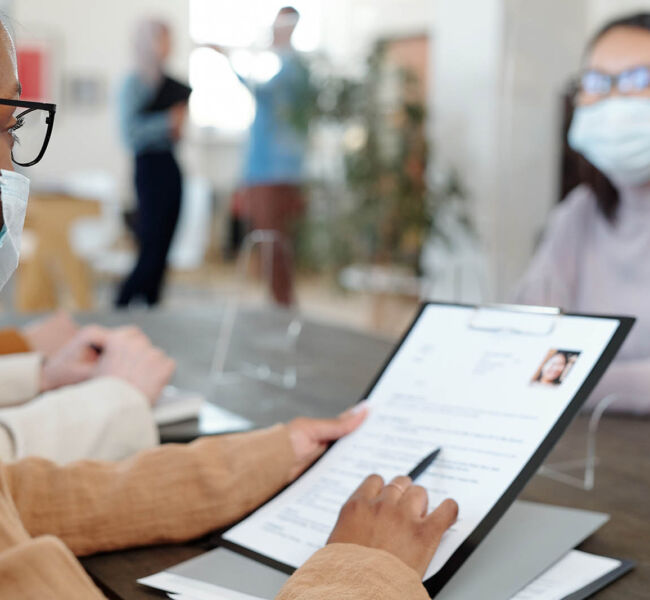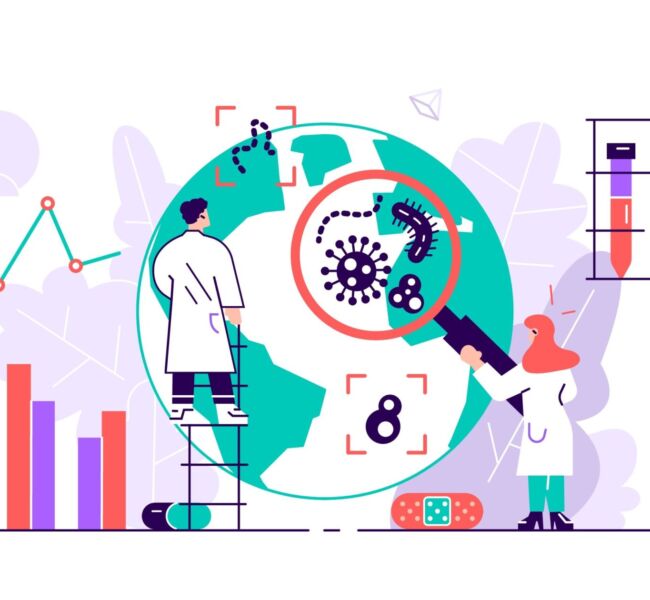A look at how the trend is unfolding in Australia, Singapore and India

In this analysis piece, the GLOBALHealthPR™ APAC team – comprising VIVA! Communications, Australia, Spurwing Communications, Singapore and MediaMedic Communications, India – gathered local insights on the role of social media in health communications, and discuss how health communicators can utilise these platforms to enhance their professional networks and maximise consumer and client outcomes.
There are more than 3.6 billion people using social media globally, with this number projected to increase to almost 4.41 billion by 2025.
Today, there are very few aspects of our lives that social media has not pervaded. These platforms are no longer used to share our personal lives with family, friends and peers, but instead, represent essential sources of local and global news, entertainment and e-commerce, and are driving the rapid expansion of virtual networks.
In recent years, social media has proved a powerful and continuously evolving resource in healthcare communications. It has provided new and innovative ways to shape and measure patient experiences through support groups and initiatives, disseminate timely education and awareness information, and strengthen connectivity between advocacy groups, healthcare professionals, patients, caregivers, researchers and industry stakeholders alike.
However, social media use can vary greatly between, and even within countries and regions. In this piece, we dive into the nuances of the local markets and their unique social media behaviour that is critical to effective healthcare communication.
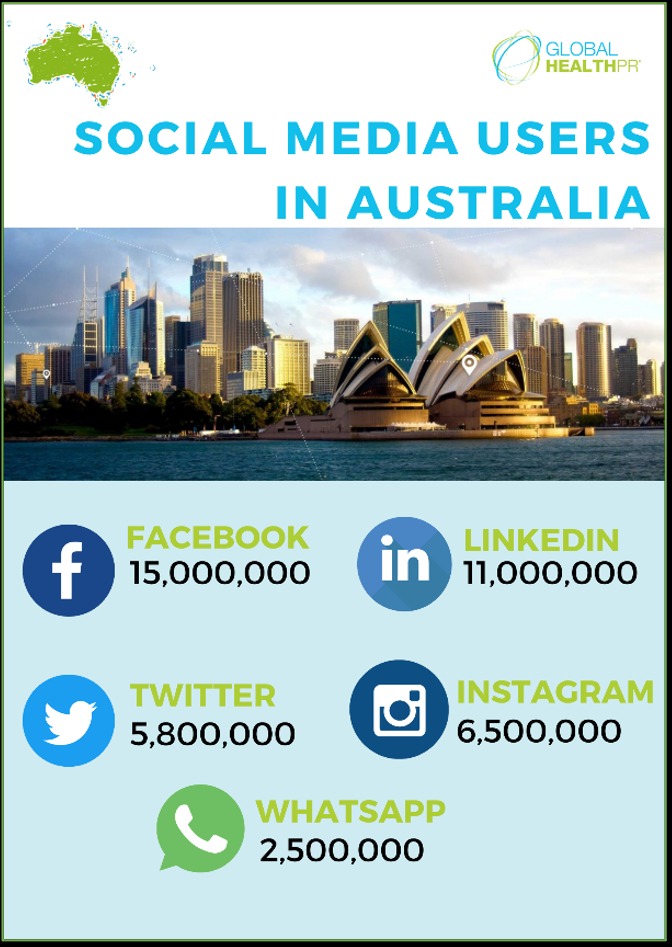
AUSTRALIA
With 80 per cent of Australians being active users of social media, these channels are an extremely valuable tool for communicating health-related topics to a large audience.
Most relevant to the Australian healthcare industry is social media giant, Facebook, with 15 million users. Patients, and patient advocacy groups (PAGs) can utilise this platform to connect with others living with, or caring for someone with a similar condition or disease.
Likewise, healthcare professionals (HCPs) and health organisations can share their knowledge and expertise, disseminate disease awareness-related information, and recruit for clinical trials via Facebook. LinkedIn, with 11 million users, is predominantly embraced by healthcare authorities to grow their professional networks, and by pharmaceutical companies wishing to build their brands and leverage corporate messaging.
Importantly, these platforms bridge the gap between healthcare professionals and patients, with the two groups more readily able to share their perspectives, challenges, and triumphs. Furthermore, patients can utilise social media to participate in research, join virtual communities, and receive financial and moral support.
In Australia, pharmaceutical companies have, for many years, cautiously approached and engaged with social media, mainly due to the highly complex, regulated environment in which they operate, and the ongoing monitoring required from a pharmacovigilance perspective. All advertising of therapeutic goods must comply with the specific requirements outlined in the Therapeutic Goods Act 1989 and the Therapeutic Goods Advertising Code (No.2) 2018. Notably, content that can be viewed by the general public should not advertise, or promote prescription products in any way.
Healthcare Professionals choosing to utilise the rapid information-sharing and convenience that these technologies offer must strive to ensure information accuracy and confidentiality. The Medical Board of Australia’s (MBA) Good Medical Practice Code of Conduct advises that ‘Behaving professionally and courteously to colleagues and other practitioners, including when using social media’, is essential.
Various challenges healthcare professionals may encounter when using social media to communicate, include maintaining compliance, confidentiality, and balancing professionalism while striving to be engaging and approachable.
Moreover, social media’s low-cost information sharing is a double-edged sword. Despite enjoying heightened access to medical information, one must also battle the accompanying murky rising tide of misinformation. It is the role of both healthcare experts and communication agencies to ensure accurate information and appropriate voices stand out amongst this information anarchy. To do so, healthcare communication agencies can position themselves as thought leaders in healthcare news, scanning industry, medical and pharmacy news for leverage via their websites and social media channels.
Instagram in particular is gaining popularity among cancer patients, providing a space to share personal stories, while fostering social belonging. Interestingly, patient networks post twice as much as health organisations on Instagram. However, the use of Instagram presents an incredible opportunity for health providers and organisations to both raise awareness, and provide tailored intervention. Instagram, as a storytelling tool, facilitates visual cancer communication, of substantial benefit in reaching cancer patients across the board. It also represents a perfect platform to both build, and reach an audience comprising those touched by rare diseases.

SINGAPORE
When the COVID-19 pandemic hit, healthcare providers and patients had limited means with which to access one another, which drove subsequent creativity with existing and new platforms. While patient-doctor interactions on mobile services and social media were then already on the rise, the restraints placed on our movement accelerated the use of these platforms. MyDoc, a telemedicine platform headquartered in Singapore, saw a surge in activity at the start of the pandemic – in February 2020, the number of daily active users rose by 60 per cent, and more than doubled once again, in March 2020.
COVID-19 has driven healthcare companies to think like a B2P (business to patient) company, and to pivot their communication by more actively utilising social media, allowing them to reach the millions of patients who access their phones more often than they see their doctors. For healthcare professionals, the use of social media extends beyond the patient. It can also serve their business operation needs.
For example, healthcare professionals can utilise social media to network with their peers, market themselves and their organisation, and to get in touch with medical representatives. Healthcare professionals tend to embrace professional platforms, such as LinkedIn, enabling them to connect with like-minded peers and professionals.
Prior to the COVID-19 pandemic, Spurwing Communications worked with Johnson & Johnson SEA to create Voices for Value – a dedicated closed group on LinkedIn for those working in hospital management and healthcare within Asia Pacific, providing a platform for members to share and discuss new trends and initiatives, and exchange learnings and insights. Over the past year, the platform has also been utilised to offer training webinars for nurses conducted by healthcare professionals across the globe – a rare opportunity for many nurses in the region. As of today, Spurwing has had more than 1,000 attendees across Asia Pacific join the group for the training purposes.
Facebook is the most popular platform with which patients engage with patient support groups in Singapore. Patients and caregivers join dedicated disease groups to share recommendations involving physicians, treatments, and diagnostics. Instagram is also increasingly being embraced as an educational platform for patients and caregivers. However, while influencer engagement is embedded in communication strategies in other parts of the world, healthcare organisations are treading with caution in Asia Pacific, on this front.
Current trends indicate that the shift to social media is perennial, demonstrated by the expansion of social media offerings and consumption. The podcast industry exceeded US$10 billion in value in 2020, and saw the emergence of Clubhouse and similar features now being explored on Facebook and Reddit. With the abundance of platforms has come an influx of information that can be misconstrued, if not conveyed appropriately. While it is important to embrace an ecosystem of platforms based on consumer behaviours, it is also vital, and our duty as healthcare communicators, to ensure that the information shared is accurate, relevant, and timely.

INDIA
The healthcare and pharmaceutical sectors in India have witnessed an evident shift to digitalisation. The growing internet penetration in smaller towns and villages has driven a surge in digital news consumption, especially in the regional languages. Video content consumption is also at its peak, offering new possibilities for communicators. With this mind, pharmaceutical and healthcare giants are increasingly utilising social media platforms to reach their target customers.
WhatsApp, owned by Facebook, is the most used social media platform in India, followed by YouTube, Facebook, Instagram and Twitter, respectively. With more than 530 million users, WhatsApp in India dominates Twitter’s 15 million users, most likely due to the presence of India’s own version of Twitter, namely Koo.
Patients use these platforms to search or share health information, communicate with experts, and to seek advice pertaining to their health concerns. Patients often communicate by commenting in dedicated, condition-specific social communities, in a bid to solve a personal, or loved one’s health-related problem.
Indian doctors leverage content via these platforms for various reasons – to increase awareness of specific health conditions, engage with patients and heighten thought leadership.
Various health influencers also engage in these conversations, serving to enhance the community reach of critical health information. Doctors, patients, channel owners and influencers also utilise social media to review products and/or therapies.
These fundamental shifts in communication are increasing the focus on healthcare professionals and patients, with communication now more customer-centric, than product-centric, data-driven and experience focused.
Given the ongoing surge in non-communicable diseases (NCD), there are huge opportunities for healthcare communicators in countries such as India, to harness these platforms for disease awareness. Connecting at the grass-roots level is becoming much easier, and simplified regional content can effectively build awareness of the NCD burden in different communities. Unfortunately however, these platforms also enable the spread of misinformation, seen with the high circulation of ‘fake news’ involving health conditions. Indian consumers are highly influenced by WhatsApp forwards, and it is in these scenarios that combating misinformation is critical, and this has been particularly evident during COVID-19.
